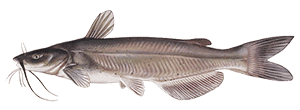Flathead Catfish

Species Details
Pylodictis Olivaris
Ictaluridae
Siluriformes
River, Lake, Flats, Backcountry
4 - 60 lbs.
12" - 61"
Flathead Catfish (Pylodictis olivaris) Fish Description
The Flathead Catfish, also known as the Yellow Cat, Mud Cat, Johnnie Cat, Pied Cat, Mississippi Cat, is known for its large size even among the North American freshwater catfish. Like any other catfish, it's known for having an “ugly” face. To some people, the Flathead Catfish may appear serpentine, its whiskers can be unsettling, and even the cleaning off the slime can be quite a turnoff for many people. Although it does look like any other catfish, its main distinction is its flat head. Their scientific name – olivaris – also comes from the olive-colored body that they have. Typically, they’re pale yellow or light brown with black spots.
Unlike the Blue and Channel Catfish, their tail is not deeply forked and has only a slight indention in it.
Flathead Catfish Diet
Generally, catfish are supposed to eat anything. But the Flathead Catfish has a preference: its prey must still be alive! They like to see their prey squirm. Flathead Catfish feed on live young fish or sometimes worms if they’re available. Flathead Catfishes also feed on crustaceans and pretty much attack anything that moves. They also eat crayfish and even their own cousins, the Channel Catfish!
Some people reported that Flathead Catfishes also like eating Green Sunfishes and the Common Carp.
Flathead Catfish Size
Flathead Catfishes are big. They grow up to 3-4 feet and can weigh more than 100 lbs! However, some people reported seeing Flathead Catfishes reaching up to 5 feet (61 inches). There appears also to be a sex difference as well wherein male Flathead Catfishes usually mature at 6 feet whereas females mature at 7 feet.
Interesting Facts about the Flathead Catfish
- People consider Flathead Catfish to have a more “superior” meat.
- It’s why they’re more popular as a gamefish.
- Not many people know this but those who have tasted a variety of catfish know that the Flathead Catfish has a different flavor and texture.
- They are considered the second-largest North American freshwater catfish.
- The first being the Blue Catfish.
- Male Flathead Catfishes are territorial.
- They often fan the eggs of the female Flathead Catfish to keep it clean and provide air.
- If a female Flathead Catfish is not healthy, she won’t lay eggs for the season.
- Although a female Flathead Catfish can lay thousands of eggs, only a few usually survive.
- Unlike some catfishes, Flathead Catfishes are not poisonous.
- Some people eat Flathead Catfishes like sushi or carpaccio.
- Usually, people bleed out a Flathead Catfish before serving it in that particular manner.
- Flathead Catfish can live up to 24 years.
Flathead Catfish – Fishing Techniques: How to Fish for a Flathead Catfish
To catch a Flathead Catfish, the first thing to secure is live bait. They want something wriggling and struggling for its life. Some people have used Perch, Bluegill, and even Goldfish to serve as decent bait! More adventurous anglers use even their own kind as bait! Others can also use the Bullhead Catfish as bait.
When catching a Flathead Catfish, most people prefer to use a rod and reel to bring in these big beasts. They usually prepare a line that can tolerate at least 50 lbs of weight. Considering that these catfish can weigh past 100, 50 lbs is assuming that it won’t struggle and snap the line. However, if you’re trying to bring in a big one and break records, some recommend doing trotlining. Trotlining can either be done via typing a line to two stumps with several hooks to catch them. Or, the other method is via drop line where a stump serves as an anchor for the line while the other is left to hang in the water.
Other people use nets to catch them especially when they gather a large amount of the Flathead Catfish’s favorite fish.
Flathead Catfish Habitat and Distribution
Flathead Catfishes prefer deep pools. They also like deep streams, rivers, canals, and some lake reservoirs. It’s why they’re also pretty common in the Great Lakes though, they’re more at the lower end where the reservoirs and the basins are. Some anglers had luck finding them in dams but they’re best found in areas where the water is deep, slow, and slightly muddy.
Flathead Catfishes also like waterways especially ones that are deep enough to accommodate a canoe.






